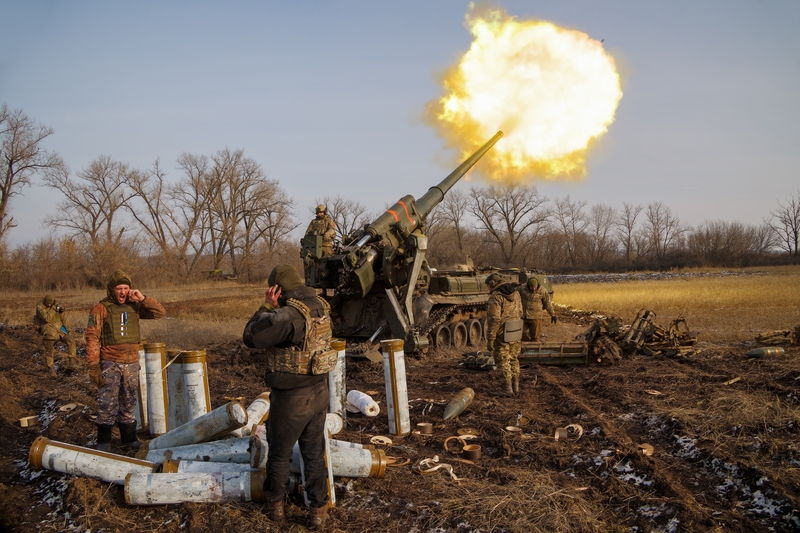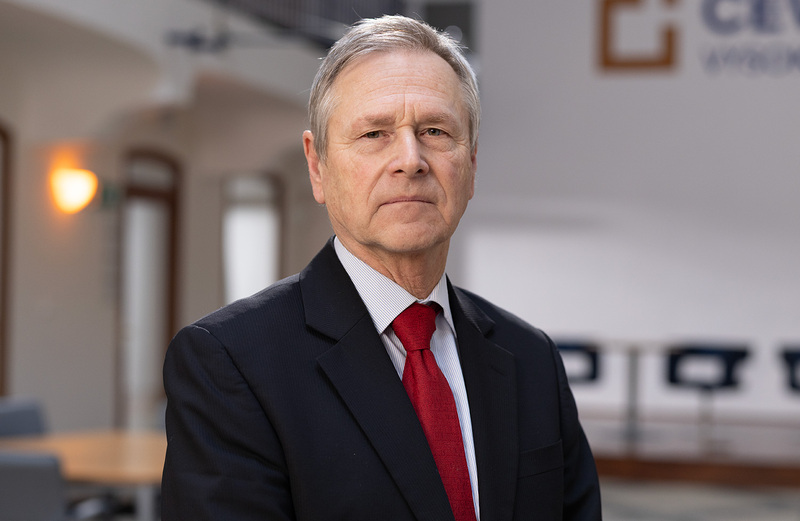Gen. Jiří Šedivý: Analysis of the second battle of Kursk
By invading Russian territory in the Sumy region, the Ukrainians shocked not only the Russian troops and their command, but also their Western allies. In a comprehensive analysis, former Chief of the General Staff of the Armed Forces General Jiří Šedivý describes what has happened in recent weeks during the Ukrainian invasion, including the Russian reaction and possible scenarios.

On August 6, Ukrainian armed forces launched a surprise attack in the Sumy region on the Russian border, crossed it and penetrated deep into Russian territory, into the Kursk region. It is often said that this was a surprise attack, but this is only partly true. The Russian soldiers and border guards had no idea what was happening at the moment when streams of Ukrainian troops were pouring over their positions. On the other hand, it was not such a big surprise.
Russian intelligence agencies and analysts had been reporting on Russian social media for some time before 6 August about the concentration of Ukrainian troops in the Sumy region. At least two weeks before the Ukrainian operation, the Chief of the General Staff of the Russian army, General Gerasimov, received this information. His response, according to Newsweek magazine, was typically Russian and was along the lines of – do not panic and do not succumb to the enemy's disinformation!
Innovative methods of warfare
On the other hand, the Ukrainians have repeatedly demonstrated an innovative way of fighting in the current conditions of the war in Ukraine. The use of passive direction and rapid forays by mobile groups at the head of advancing troops, consisting of relatively small teams of complexly equipped and capable of rapid manoeuvre mechanised units on wheeled armoured personnel carriers, supported by tanks, artillery, air defence, but also by the massive use of REB (Electronic warfare – EW), which blinded Russian reconnaissance assets and prevented the communication of Russian communications systems - a method of effective command. Important was and is the use of drones and the elimination of Russian assets (if at all the Russians had any such assets in the area) and support, albeit limited, by the Ukrainian Air Force (according to an unverified report, the first F16s delivered to Ukraine participated in the support).
In a short time, the Ukrainians advanced to a depth of up to 30 km. On 13 August, the commander of the Ukrainian army, General Syrsky, stated that the Ukrainian army controlled up to 1,000 km2 of Russian territory. This, however, seems to be an exaggerated figure. But it is true that mobile strike groups can operate on such territory. Behind the first troops, a part designed to build on the successes achieved or to secure the lines reached has moved into the area. According to some accounts, two brigades (some sources say as many as five brigades) and other support forces, estimated at up to 10,000 troops, moved into the area. However, reports on 14 August already indicate a slowing of the Ukrainian troop advance to one to three kilometres per day. This indicates that the first Russian reserves had already been deployed into the fighting, having been moved from the nearest possible areas, but especially from the northern cluster of Russian troops that was intended to support Russian troops on the "Kharkov" direction. But there is no doubt that by 14 August the Ukrainian forces had reached a depth of 30 km into Russian territory and the Russians were unable to stop their advance completely.
Russia is not taking the whole situation lightly and is concentrating a rather massive battle group to destroy the Ukrainian incursion into Russian territory. First of all, the Russian command is trying to consolidate the troops that are in the area and ensure their minimum combat capability. Troops of the 6th Army of the Leningrad Military District (1,009th Motorized Artillery Regiment), and the 11th Army Corps (79th Motorized Artillery Regiment), the 1st Guards Tank Army, the Moscow Military District (272nd Motorized Artillery Regiment), the 6th Independent Motorized Artillery Brigade (138th Motorized Artillery Battalion), and others are moving into the area. From other parts of the battlefield, the Russians are withdrawing two airborne battalions (VDV) and elements of the 810th Marine Infantry Brigade (Black Sea Fleet) from the direction of Kherson; elements of the 38th and 64th Motorized Artillery Brigades (35th Allied Army) of the Eastern Military District from the direction of Zaporozhye.
Russian moves without weakening the main lines of offensive
According to the findings of Ukrainian intelligence, other, volunteer corps are also withdrawing to the Kursk region, including followers of Wagner's group, Chechens, etc. A battalion of unmanned aerial vehicles also moved into the battle area to support the Russian forces. Lithuanian intelligence services have confirmed Russian troop movements from the Kaliningrad region. These forces are to stop and then push back the Ukrainian troops. However, it is already clear from the list of parts of the troops being moved (the information is not verifiable) that the Russian command does not want to weaken the main offensive lines, especially on the eastern battlefield, and that it will continue to exert pressure on the two main lines – on Pokrovsk and on Chasiv Yar, and apparently avoid moving significant elements of combat-effective units on these lines. This is evidenced by the fact that some troops have been withdrawn from the southern front - the Zaporozhye and "Kherson" areas, the "Kupyansk" battle area and, logically, from the "Kharkov" battle area, but not from those directions (at least not until August 14).
At the time of writing, however, the balance of power is probably still in favour of the Ukrainian troops. According to the available information, the Ukrainian contingent of troops carrying out the task in the Kursk region numbers more than 10,000 soldiers. The Russians have so far concentrated less than Ukraine's 10,000 in the manner indicated. Certainly the number of troops will increase, but the slowness of the fulfillment of the "Kursk" battle group also means further losses of Russian territory.
At the same time, this composition will suffer from the flawed Russian concept of assembling troops according to their reach. Even though, according to President Putin's instructions, this grouping is commanded by the 'Commander of the Northern Group of Troops', which is essentially the responsibility of the Leningrad Military District (since May, it has been commanded by Colonel General Alexander Lapin, a well-known figure in this aggression), it is such a disparate grouping that it will be very difficult to command it and to ensure adequate synergy.
A strangely complicated command structure against the Ukrainian invasion
The entire organizational structure of the newly formed army group designed to deal with the Ukrainian incursion into Russian territory exhibits a familiar Russian quirk that was, among other things, the reason for Russia's failure in the early days of the Russian aggression (and let's be glad for that). But the Russian command of this operation itself is also complicated. Russia's National Anti-Terrorist Committee announced the launch of an anti-terrorist operation in the Belgorod, Bryansk and Kursk regions on August 9, 2024, in response to the Ukrainian offensive on Russian territory.
Putin probably appointed Bortnikov as the commander of this anti-terrorist operation because Article 13 of the Russian Federal Law "On Combating Terrorism" states that "the person who made the decision to carry out an anti-terrorist operation ... is the commander of the anti-terrorist operation and bears personal responsibility for its course" – a decision made by Bortnikov. At the same time, however, Putin said that "the overlapping tasks of the Ministry of Defence (MoD), the Federal Security Service (FSB) and Rosgvardia in the Ukrainian-Russian border area are entrusted to the Ministry of Defence, which is to assemble a group of forces in the Kursk region and also to create a joint command and control (C2) system to coordinate the operation". The main task of the Ministry of Defence is to push Ukrainian forces out of Russian territory. The Ministry of Defence, together with the border service (subordinated to the FSB), is to "ensure reliable coverage of the state border". The FSB and Rosgvardia are to "combat (Ukrainian) sabotage and reconnaissance groups", while Rosgvardia is also to provide "its own combat missions". The FSB and Rosgvardia are also to ensure a regime of counter-terrorist operations and that the FSB, with Rosgvardia's support, will set up a "headquarters" to do so. But Article 9 of the Russian Law on Anti-Terrorist Operations states that "units and services of the RF Armed Forces are involved in the implementation of an anti-terrorist operation on the basis of a decision of the commander of the anti-terrorist operation".
But Putin also appointed his adviser Alexei Dyumin to oversee Russia's "anti-terrorist operation" in the Kursk region and instructed him to coordinate all "agencies" involved in repelling the Ukrainian invasion of the Kursk region. To make matters worse, Colonel General Yevgeny Nikiforov (formerly commander of the Western Military District with the rank of Lieutenant General), who is presumably the Chief of Staff of the Russian Ground Forces, arrived in the area and his role is still unknown.
Such a complicated set-up designed to stop and dislodge Ukrainian forces will find it difficult to find an appropriate level of synergy, not to mention that this command system will also be cumbersome for various and competency reasons. Sooner or later, Russia will assemble a force capable of pushing Ukrainian troops out of its territory. However, the future of the existence of the top officials of the Russian security system, including the Chief of the General Staff of the Russian army, General V. Gerasimov, is also at stake.
Will the Ukrainians risk their best ground troops to hold Russian territory?
It can be assumed that, despite the difficulties in the command and control system of the operation, measures will be taken at this stage to stop Ukrainian troops penetrating deep into Russian territory once all designated forces have been moved and deployed. To this end, strikes have been, and will continue to be, carried out by air, missile, artillery and unmanned aerial vehicles not only on Ukrainian troops but also on supply lines in the Sumy area. Once the advance of Ukrainian troops has been halted, the main effort is likely to be focused on the directions and on the retaking of Suzi and the elimination of Ukrainian troops to the south. Korenevo and S. Kurchatov (Kursk nuclear power plant). At this point, it will be crucial whether the Ukrainian army manages to carry out at least basic excavation and mine clearance work to build a provisional line of defence. If the Ukrainians succeed in doing so, it would be a very good outcome of the whole operation and probably the fulfilment of the unspoken objective of the possibility of a territorial exchange. Only that would require a fairly large concentration of Ukrainian troops and would also mean weakening other directions with the threat of losing Ukrainian territory elsewhere. Even if Russian stocks of equipment and ammunition are dwindling, this cannot be counted on. North Korea in particular may increase its arms supplies, although they are probably not of the best quality. Even China and Iran would not stand aside at a critical moment.

The only solution is our massive supply of the necessary material so that Ukraine can eliminate the Russian superiority by the quality of its weapons. But in mid-August it does not look like that. Perhaps because the Ukrainian leadership has not mentioned this operation even to the US, let alone to its lesser partners in Europe. The downside is also that we are not prepared for any urgent demand for more supplies. It may be that the best Ukrainian ground forces will bleed to death in the Kursk region. This would not fulfil the probable intention, as President Zelensky has stated, of protecting Ukraine's borders with the Kursk region and thus preventing the conducting of strikes on the Sumy region. Thus, the necessary push of the Russian army away from the border with Ukraine. No less significant would be forcing the Russians to move a significant portion of their troops from threatened directions to the Kursk region, thereby relieving the resisting Ukrainian troops in eastern Ukraine and redirecting some of the flow of logistical support to that part of the front. The occupation of part of Russian territory is also linked to the disruption of communications in this territory. Another objective, as President Zelensky has stated, is to create a so-called 'exchange fund'. He probably meant the number of Russian prisoners who can be exchanged for Ukrainian prisoners. The content of the statement by Ukrainian Foreign Ministry spokesman Heorhia Tykhya on 13 August, who said that Ukraine was not interested in occupying territory in the Kursk region, is not entirely clear. From the quite unmistakable start of the building of defences by Ukrainian troops on the achieved line, this is rather reminiscent of the previously presented idea (mentioned above) of Ukrainian leaders, which would mean occupying part of Russian territory and holding it, and using this occupied territory to exchange for Russian-occupied territory when negotiating a ceasefire with Russia. It is a vision that is possible under favorable conditions.
But if the operation goes badly, just as the position of Russian Army Chief of General Staff Valery Gerasimov is threatened, so too will the position of Ukrainian army commander Oleksandr Syrsky.





















